For more information, visit https://www.ruger.com/.
To purchase a Ruger LCP II on GunsAmerica.com, click this link: https://www.gunsamerica.com/Search.aspx?T=LCP%20II.
Making improvements to an iconic firearm is always a tough decision. And yes, the Ruger LCP is iconic; it was one of the significant catalysts for the now prolific variety of .380 ACP pocket pistols on the market, and the resurgence of interest in the .380 caliber, which has benefited from this gun’s popularity by becoming one of the most commonly seen (and surprisingly capable) small-caliber defensive rounds in use today.
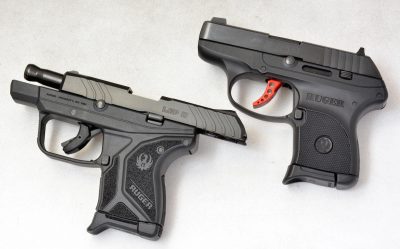
The LCP II (left) brings a locking-open slide system on empty magazines and also a radically recontoured shape.
Despite the fact that the LCP wasn’t introduced until five years after the Kel-Tec P-3AT (to read a full review of this pistol on GunsAmerica.com, click this link), the first modern .380 pocket pistol, the popularity of any new gun is, ironically, a little like comedy; it’s all is the timing. In 2008, the timing was right; the Ruger name and the pistol’s excellent design helped the little .380 knock it out of the park. The .380 ACP suddenly emerged from the shadows long cast by the most famous .380 pistol in the world, the Walther PPK (to read a review of this firearm on GunsAmerica.com, click this link).
Less Than Perfect
The LCP for all its technological advances in design and construction had its flaws, and there were minor changes made to the pistol over the first several years, but the real issues for gun owners were never quite addressed, such as poor sights, a heavy trigger pull, a slide that was hard to rack when chambering the first round or clearing the gun, and a slide that did not lock back after the last round was fired.
In terms of familiarization, the original LCP version is a hammer-fired, locked breech, recoil operated semi-auto with an internal hammer. The hammer can be clearly seen resting flush against the back of the slide when the action has been cycled. If it isn’t there the action is not ready to fire, making this a very quick check of the gun’s condition. In addition, the trigger, though remaining in its forward position, has zero resistance if the slide has not been cycled. And last, there is a loaded chamber view port at the breech that exposes the rim of a chambered cartridge. While it is unusual for a pistol as small as the LCP to use a locked breech design, as opposed to blowback operation common with many .380s, Ruger opted for the locked breech design to avoid the large slides and heavy recoil springs found with blowback guns.
Many of the issues gun owners had with the LCP’s sights, slide and trigger were partially addressed in 2015 with the LCP Custom (to read a full review of this pistol on GunsAmerica.com, click this link), which introduced a more durable stainless steel guide rod, a slide with slightly less resistance, but most significantly, a new trigger design and much-needed improved front and rear sights. With a very unapologetic bright red skeletonized aluminum trigger and polished blue slide fitted with a tall, square notched dovetailed (windage adjustable) rear sight and raised white dot photoluminescent front blade, it was such an improvement over the original LCP that there was scarcely a basis for comparison, except for still having a slide that would not lock back after the last round was fired. Fast forward one year.
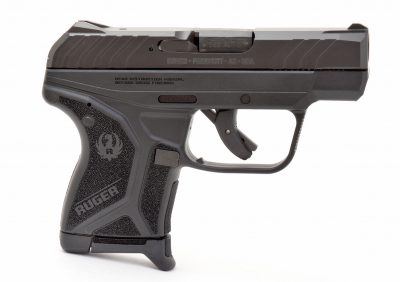
The LCP II still has the characteristics that made the first LCP popular—namely compact size yet capable power—and kicks it up a notch.
SPECS
- Chambering: .380 ACP
- Barrel: 2.75 inches
- OA Length: 5.16 inches
- Weight: 10.6 ounces
- Grips: Integral
- Sights: Low profile
- Action: SAO
- Finish: Matte black
- Capacity: 6+1
- MSRP: $349
Two Steps Forward
The 2016 LCP II has fully addressed the issue of a slide that locks back after the last round is fired. And the crowd goes wild! They’ve even gone one step further with a new, integrated blade safety trigger design evolved from the LC9s, that, and I say this with a great deal of respect for the “Red Trigger Ruger” (which I carry every day), makes the LCP II worth stepping up for. The average trigger pull on an LCP is 6.5 pounds; the new LCP II trigger has a resistance of 5 pounds, 11 ounces on average. Ruger describes it as having a single-action-only (SAO) trigger. It has a long 0.75 inches of travel, firm stacking for the last 0.5 inches with a clean break, and short reset. Although it may seem strange to describe a trigger like this as a single-action, I think that Ruger’s reasoning behind this is that a double-action-only (DAO) would fully cock the hammer when you pull the trigger, and the LCP needs to have the slide cycled to set the hammer for the gun to be able to be fired. As a result, it offers no second-strike capability but the new slide requires only half as much effort to rack, and a short stroke to re-cock the internal hammer in the event of a misfire. It is a much-improved trigger and slide design, and I really liked the “Red Trigger Ruger” LCP Custom. One other change to the pistol’s internal hammer-fired design is that only the top third of the hammer, rather than the entire back of the hammer, appears in the rear slide opening when the action is cycled. This is a little harder to see, but adequate. But this is not the only new feature that is just adequate.

The new LCP II comes standard with a pocket holster, giving you a carry-ready gun right out of the box.
Two Steps Back
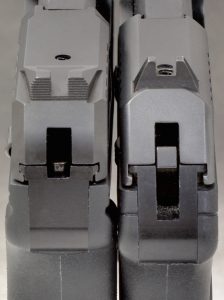
Only the top third of the LCP II’s hammer (left), rather than the entire back of the hammer, appears in the rear slide opening when the action is cycled.
Having assuaged two of the LCP’s greatest deficits, a slide that does not lock back and a slide with too much recoil spring resistance, Ruger also changed the contours of the slide, added new, crescent shaped slide serrations, not only at the rear but at the front of the slide, which is very effective with the lighter recoil spring resistance, reshaped the glass-filled nylon frame for a modestly improved hand hold, and completely redesigned the triggerguard, giving it an elongated base and squared off front for more trigger finger clearance. So, how is all of this not good? It’s all good except for the sights. For some inexplicable reason the LCP II has reverted back to a variation of the original molded-in design, which almost totally negates the advantages gained by the improved LCP Custom model. Once again you have a through-hardened steel slide with a matte black finish and small, hard-to-acquire black sights (though not as small as the original LCP and with a slightly greater sight radius). The sights on the LCP II are definitely better, but a step back from the LCP Custom. The second step back is really more of a sidestep; the new frame and triggerguard designs make it impossible to use any existing LCP Laserguards or current contoured leather or Kydex belt and shoulder holsters. This, of course, will correct itself as the aftermarket responds with LCP II accessories. Fortunately, it comes with its own pocket holster and still fits the majority of pocket rigs like the DeSantis Nemesis, and my everyday carry Elite Survival Systems BCH 10 ballistic nylon belt clip holster.
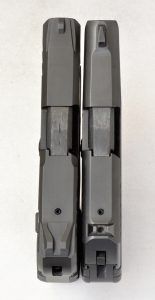
The overall dimensions of the new LCP II (left) are quite similar to that of the original LCP pistol.
In weight and handling, the LCP II checks in at 10.6 ounces with an empty magazine, that’s about one ounce more than the current LCP; a negligible difference. Barrel length remains the same at 2.75 inches; the new slide contours increase the mass but not the overall length at 5.16 inches and height is 3.7 inches, a fraction taller than the standard LCP at 3.60 inches, and about the same as the LCP Custom. The LCP II also introduces a new grip contour with raised rear side panels stepping down to lower front panels that wrap around the frontstrap. They also have a rough stippled finish for a more tactile hold.
One of the more noteworthy changes to the LCP II grip contour is a reshape of the curvature of the integrated thumb rest from the horizontal indentation on the LCP to one where the front joint of the thumb naturally tips downward. This induces a slightly stronger grasp on the small .380 pistol.
As one might expect, the standard LCP six-round magazine will not work with the LCP II (they fit inside the grip well but will not allow a round to be chambered). Interestingly, LCP II magazines will fit into an older LCP and chamber a round, but they won’t lock the slide back. So, if you end up with both guns, be sure to keep your house in order to avoid a magazine mix up.
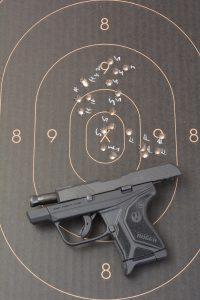
The author found that the LCP II performed quite well at 7 yards with the three types of ammo he used.
Different by only fractions of an inch and 1.0 ounces, the new LCP stacks up against the original model (and even the LCP Custom Red Trigger model) as a better handling gun. But, how does it shoot? All things being equal, or nearly so, with a lighter trigger, revised recoil system, and new slide design, it should be easier to handle and thus a bit more accurate at a combat distance of 7 yards (21 feet).
To keep everything equal for testing I used the same test ammo from an LCP Custom T&E I did about a year ago. That was done with Sig Sauer Elite Performance V-Crown 90-grain JHP, Federal Premium 99-grain HST JHP, and Sig Sauer’s 100-grain Elite Performance, slightly heavier than standard grain weight FMJ round. All ammo from the LCP Custom T&E clocked in well over 800 fps (feet per second) from the short 2.75 inch barrel, with Federal Premium HST JHP clearing the traps at an average of 886 fps, Sig Sauer JHP just a hair behind at 882 fps average, and the FMJ Sig Elite Performance traveling at an average of 825 fps. The same three fired from the LCP II were all a little slower, clocking 857 fps, 896 fps and 803 fps average, respectively.
 The LCP Custom was consistently good with average groups from all three brands of ammo under 2.5 inches. The LCP II proved faster to reload, and with the new trigger design and lighter trigger pull delivered a best five-shot group with Sig JHP measuring at 1.76 inches, Sig FMJ at 1.50 inches and Federal HST a best five-shot group at 1.26 inches with two overlapping.
The LCP Custom was consistently good with average groups from all three brands of ammo under 2.5 inches. The LCP II proved faster to reload, and with the new trigger design and lighter trigger pull delivered a best five-shot group with Sig JHP measuring at 1.76 inches, Sig FMJ at 1.50 inches and Federal HST a best five-shot group at 1.26 inches with two overlapping.
Final Thoughts
The differences in accuracy at 21 feet were minimal, and the gun is faster to fire. It does, however, have snappier recoil than the older LCP and LCP Custom models. The difference here once again is minimal, and overall the LCP II outperforms the LCP and LCP Custom. And when that slide locks back, you know it’s time to reload.
With a suggested retail of $349, which is $90 more than the standard LCP and $80 more than the LCP Custom, the LCP II comes off as a much-improved handgun overall; it’s easier to operate, easier to load, and just as accurate. All it needs is better sights. The road to perfection is a long one, but this one is definitely heading in the right direction.
For more information, visit https://www.ruger.com/.
To purchase a Ruger LCP II on GunsAmerica.com, click this link: https://www.gunsamerica.com/Search.aspx?T=LCP%20II.
